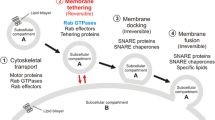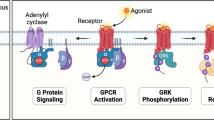Abstract
Expression of functionally active mammalian histamine H1- and H2-receptors was recently demonstrated in Sf9 cells. Either receptor elicited phosphoinositide degradation leading to an increased cytoplasmic calcium concentration. In the present study we focussed on identifying the Sf9 guanine nucleotide-binding proteins (G proteins) involved. Immunodetection of Sf9 membranes showed expression of Gα isoforms belonging to all four G protein subfamilies. During prolonged baculovirus infection of Sf9 cells, binding of guanosine 5’-o-(3-thiotriphosphate) as well as the intensities of G protein immunoreactivity, pertussis toxin-mediated ADP-ribosylation, GTP azidoanilide labelling of Gα, and phosphate-labelling of Gβ declined in cell membranes. Some 48h after infection with mammalian histamine receptor-encoding viruses virtually no functional coupling of ligand-activated receptors to insect G proteins was observed despite a high level of expressed receptors. In contrast, Sf9 cells infected only for 28h allowed studies on histamine-induced G protein coupling. In membranes obtained from H1-receptor-expressing cells, histamine increased incorporation of GTP azidoanilide into G q/11-like proteins whereas in membranes containing H2-receptors histamine enhanced GTP azidoanilide-labelling of G q/11-like and Gs-like proteins. In fura-loaded H1- and H2-receptor-expressing cells histamine induced the release of calcium from intracellular stores. This study shows firstly that Sf9 G proteins couple to mammalian histamine receptors and secondly that H1-receptors activate only Gq/11, whereas H2-receptors activate Gq/11 and Gs, but neither receptor couples to Gi/o or G12. Finally, the time following baculovirus infection is critical for studying the functional coupling between recombinantly expressed and endogenous signal transduction components.
Similar content being viewed by others
Author information
Authors and Affiliations
Additional information
Received: 24 January 1997 /Accepted: 14 April 1997
Rights and permissions
About this article
Cite this article
Leopoldt, D., Harteneck, C. & Nürnberg, B. G Proteins endogenously expressed in Sf 9 cells: interactions with mammalian histamine receptors. Naunyn-Schmiedeberg's Arch Pharmacol 356, 216–224 (1997). https://doi.org/10.1007/PL00005044
Issue Date:
DOI: https://doi.org/10.1007/PL00005044




